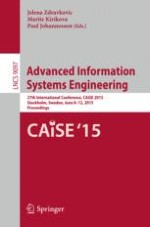This book constitutes the proceedings of the 27th International Conference on Advanced Information Systems Engineering, CAiSE 2015, held in Stockholm, Sweden, in June 2015.
The 31 papers presented in this volume were carefully reviewed and selected from 236 submissions. They were organized in topical sections named: social and collaborative computing; business process modeling and languages; high volume and complex information management; requirements elicitation and management; enterprise data management; model conceptualisation and evolution; process mining, monitoring and predicting; intra- and inter-organizational process engineering; process compliance and alignment; enterprise IT integration and management; and service science and computing. The book also contains the abstracts of 3 keynote speeches and 5 tutorials, presented at the conference.
